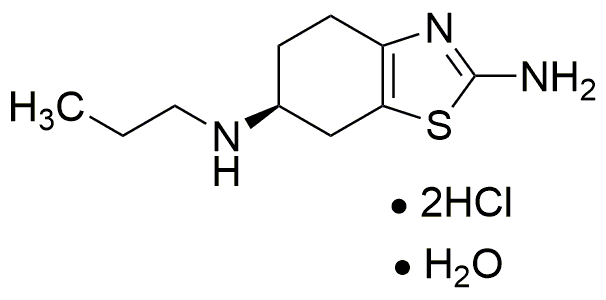Pramipexole dihydrochloride monohydrate is widely utilized in research focused on:
- Treatment of Parkinson's Disease: This compound is primarily used in the management of Parkinson's disease, helping to alleviate symptoms such as tremors and stiffness, thereby improving the quality of life for patients.
- Restless Legs Syndrome (RLS): It is effective in treating RLS, providing relief from uncomfortable sensations in the legs, which can disrupt sleep and daily activities.
- Neuroprotective Research: Researchers explore its neuroprotective properties, investigating its potential to protect neurons from damage, which could lead to advancements in treating neurodegenerative disorders.
- Clinical Trials: The compound is frequently involved in clinical trials aimed at discovering new therapeutic uses, enhancing its role in pharmaceutical development.
- Combination Therapies: It is often studied in combination with other medications to assess synergistic effects, potentially leading to more effective treatment regimens for various neurological conditions.
General Information
Properties
Safety and Regulations
Applications
Pramipexole dihydrochloride monohydrate is widely utilized in research focused on:
- Treatment of Parkinson's Disease: This compound is primarily used in the management of Parkinson's disease, helping to alleviate symptoms such as tremors and stiffness, thereby improving the quality of life for patients.
- Restless Legs Syndrome (RLS): It is effective in treating RLS, providing relief from uncomfortable sensations in the legs, which can disrupt sleep and daily activities.
- Neuroprotective Research: Researchers explore its neuroprotective properties, investigating its potential to protect neurons from damage, which could lead to advancements in treating neurodegenerative disorders.
- Clinical Trials: The compound is frequently involved in clinical trials aimed at discovering new therapeutic uses, enhancing its role in pharmaceutical development.
- Combination Therapies: It is often studied in combination with other medications to assess synergistic effects, potentially leading to more effective treatment regimens for various neurological conditions.
Documents
Safety Data Sheets (SDS)
The SDS provides comprehensive safety information on handling, storage, and disposal of the product.
Product Specification (PS)
The PS provides a comprehensive breakdown of the product’s properties, including chemical composition, physical state, purity, and storage requirements. It also details acceptable quality ranges and the product's intended applications.
Certificates of Analysis (COA)
Search for Certificates of Analysis (COA) by entering the products Lot Number. Lot and Batch Numbers can be found on a product’s label following the words ‘Lot’ or ‘Batch’.
*Catalog Number
*Lot Number
Certificates Of Origin (COO)
This COO confirms the country where the product was manufactured, and also details the materials and components used in it and whether it is derived from natural, synthetic, or other specific sources. This certificate may be required for customs, trade, and regulatory compliance.
*Catalog Number
*Lot Number
Safety Data Sheets (SDS)
The SDS provides comprehensive safety information on handling, storage, and disposal of the product.
DownloadProduct Specification (PS)
The PS provides a comprehensive breakdown of the product’s properties, including chemical composition, physical state, purity, and storage requirements. It also details acceptable quality ranges and the product's intended applications.
DownloadCertificates of Analysis (COA)
Search for Certificates of Analysis (COA) by entering the products Lot Number. Lot and Batch Numbers can be found on a product’s label following the words ‘Lot’ or ‘Batch’.
*Catalog Number
*Lot Number
Certificates Of Origin (COO)
This COO confirms the country where the product was manufactured, and also details the materials and components used in it and whether it is derived from natural, synthetic, or other specific sources. This certificate may be required for customs, trade, and regulatory compliance.


